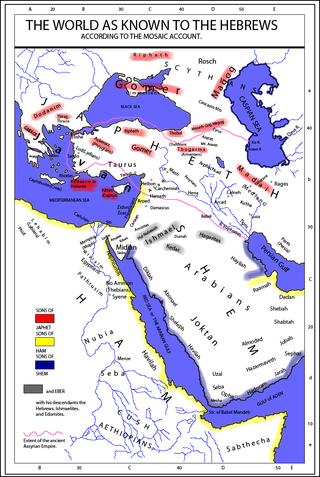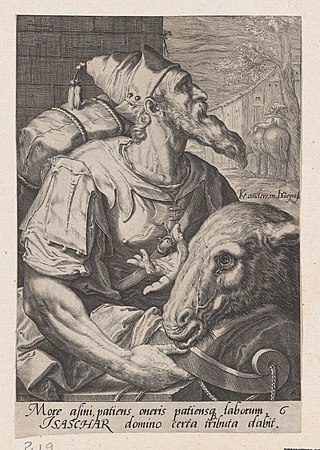
Japheth is one of the three sons of Noah in the Book of Genesis, in which he plays a role in the story of Noah's drunkenness and the curse of Ham, and subsequently in the Table of Nations as the ancestor of the peoples of the Aegean Sea, Anatolia, Caucasus, Greece, and elsewhere in Eurasia. In medieval and early modern European tradition he was considered to be the progenitor of the European peoples.

Noah appears as the last of the Antediluvian patriarchs in the traditions of Abrahamic religions. His story appears in the Hebrew Bible, the Quran and Baha'i writings. Noah is referenced in various other books of the Bible, including the New Testament, and in associated deuterocanonical books.

The Tower of Babel is an origin myth and parable in the Book of Genesis meant to explain the existence of different languages and cultures.
Tarshish occurs in the Hebrew Bible with several uncertain meanings, most frequently as a place far across the sea from Phoenicia and the Land of Israel. Tarshish was said to have exported vast quantities of important metals to Phoenicia and Israel. The same place name occurs in the Akkadian inscriptions of Assyrian king Esarhaddon and also on the Phoenician inscription of the Nora Stone in Sardinia; its precise location was never commonly known, and was eventually lost in antiquity. Legends grew up around it over time so that its identity has been the subject of scholarly research and commentary for more than two thousand years.

The Generations of Noah, also called the Table of Nations or Origines Gentium, is a genealogy of the sons of Noah, according to the Hebrew Bible, and their dispersion into many lands after the Flood, focusing on the major known societies. The term 'nations' to describe the descendants is a standard English translation of the Hebrew word "goyim", following the c. 400 CE Latin Vulgate's "nationes", and does not have the same political connotations that the word entails today.

Enoch is a biblical figure and patriarch prior to Noah's flood, and the son of Jared and father of Methuselah. He was of the Antediluvian period in the Hebrew Bible.

Asher, in the Book of Genesis, was the last of the two sons of Jacob and Zilpah and the founder of the Israelite Tribe of Asher.

According to the Bible, Jochebed was a daughter of Levi and mother of Miriam, Aaron and Moses. She was the wife of Amram, as well as his aunt. No details are given concerning her life. According to Jewish legend, she is buried in the Tomb of the Matriarchs, in Tiberias. In the New Testament, she is praised for her faith in God.

Lud was a son of Shem and grandson of Noah, according to Genesis 10.
Tubal, in Genesis 10, was the name of a son of Japheth, son of Noah. Modern scholarship has identified him with Tabal. Traditionally, he is considered to be the father of the Caucasian Iberians according to primary sources. Later, Saint Jerome refashioned the Caucasian Iberia (Georgia) into the Iberian Peninsula and Isidore of Seville consolidated this idea.

Issachar was, according to the Book of Genesis, the fifth of the six sons of Jacob and Leah, and the founder of the Israelite Tribe of Issachar. However, some Biblical scholars view this as an eponymous metaphor providing an aetiology of the connectedness of the tribe to others in the Israelite confederation.

Keturah was a wife and a concubine of the Biblical patriarch Abraham. According to the Book of Genesis, Abraham married Keturah after the death of his first wife, Sarah. Abraham and Keturah had six sons. According to Jewish tradition, she was a descendant of Noah's son Japheth.

Reuben or Reuven was the first of the six sons of Jacob and Leah, according to the Book of Genesis. He was the founder of the Israelite Tribe of Reuben.

Kittim was a settlement in present-day Larnaca on the east coast of Cyprus, known in ancient times as Kition, or Citium. On this basis, the whole island became known as "Kittim" in Hebrew, including the Hebrew Bible. However the name seems to have been employed with some flexibility in Hebrew literature. It was often applied to all the Aegean islands and even to "the W[est] in general, but esp[ecially] the seafaring W[est]". Flavius Josephus records in his Antiquities of the Jews that

The term Japhetites refers to the descendants of Japheth, one of the three sons of Noah in the Book of Genesis. The term was used in ethnological and linguistic writings from the 18th to the 20th centuries as a Biblically derived racial classification for the European peoples, but is now considered obsolete. Medieval ethnographers believed that the world had been divided into three large-scale groupings, corresponding to the three classical continents: the Semitic peoples of Asia, the Hamitic peoples of Africa, and the Japhetic peoples of Europe.
Zimran, also known as Zambran, was, according to the Hebrew Bible, the first son of the marriage of Abraham, the patriarch of the Israelites, to Keturah, whom he wed after the death of Sarah. Zimran had five other brothers, Jokshan, Medan, Midian, Ishbak, and Shuah.

Josippon is a chronicle of Jewish history from Adam to the age of Titus. It is named after its supposed author, Flavius Josephus, though it was actually composed in the 10th century in Southern Italy. The Ethiopic version of Josippon is recognized as canonical by the Ethiopian Orthodox Tewahedo Church and the Eritrean Orthodox Tewahedo Church.

Ashkenaz in the Hebrew Bible is one of the descendants of Noah. Ashkenaz is the first son of Gomer, and a Japhetic patriarch in the Table of Nations. In rabbinic literature, the descendants of Ashkenaz were first associated with the Scythian cultures, then later with the Slavic territories, and, from the 11th century onwards, with Germany and northern Europe, or the Indo-European people, in a manner similar to Tzarfat or Sefarad.
There is no scholarly consensus as to when the canon of the Hebrew Bible was fixed. Rabbinic Judaism recognizes the twenty-four books of the Masoretic Text as the authoritative version of the Tanakh. Of these books, the Book of Daniel of Ketuvim has the most recent final date of composition. The canon was therefore fixed at some time after this date. Some scholars argue that it was fixed during the Hasmonean dynasty, while others argue it was not fixed until the second century CE or even later.

Since early modern times, a number of biblical ethnonyms from the Table of Nations in Genesis 10 have been used as a basis for classifying human racial and national identities. The connection between Genesis 10 and contemporary ethnic groups began during classical antiquity, when authors such as Josephus, Hippolytus and Jerome analyzed the biblical list.